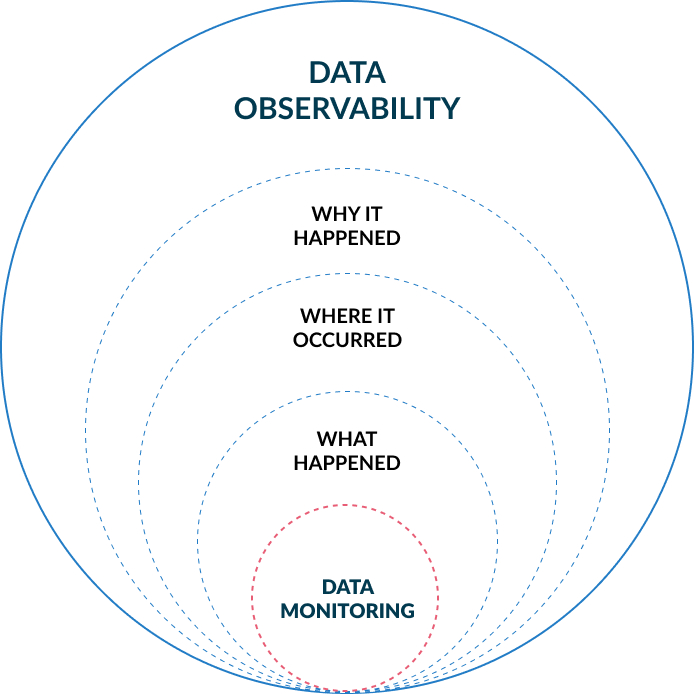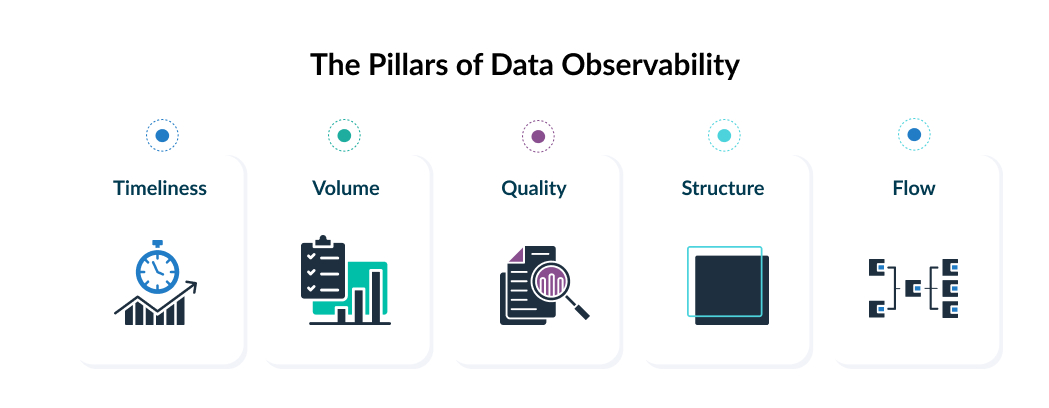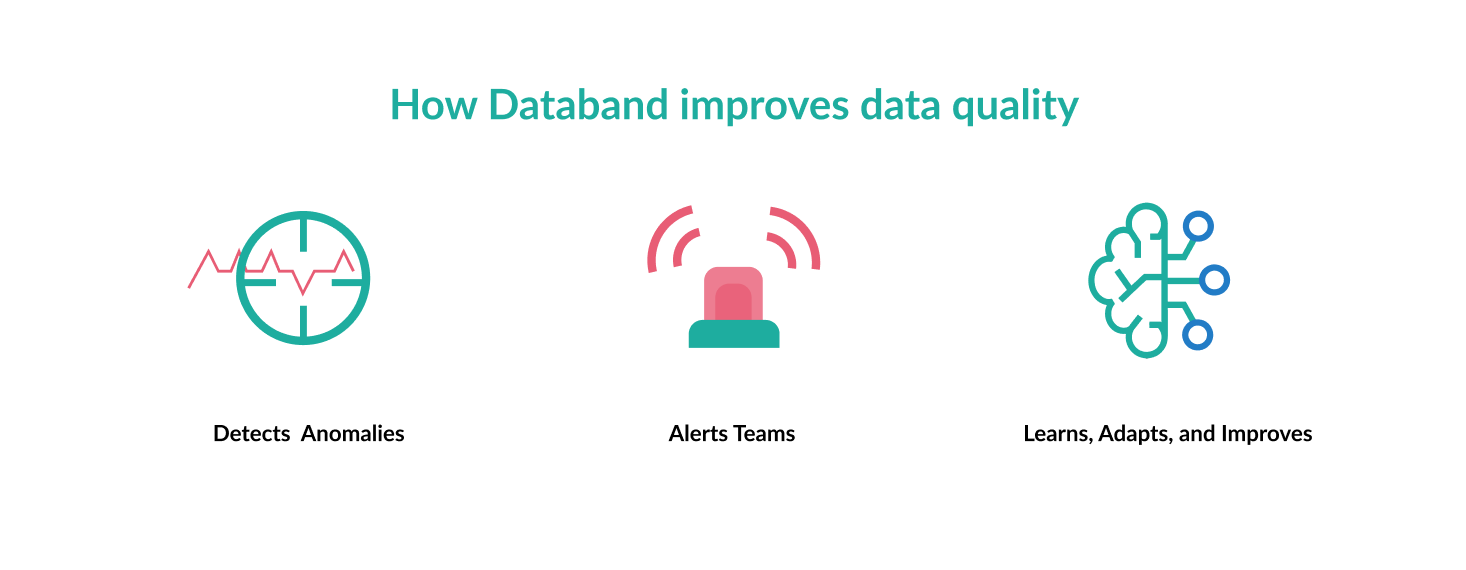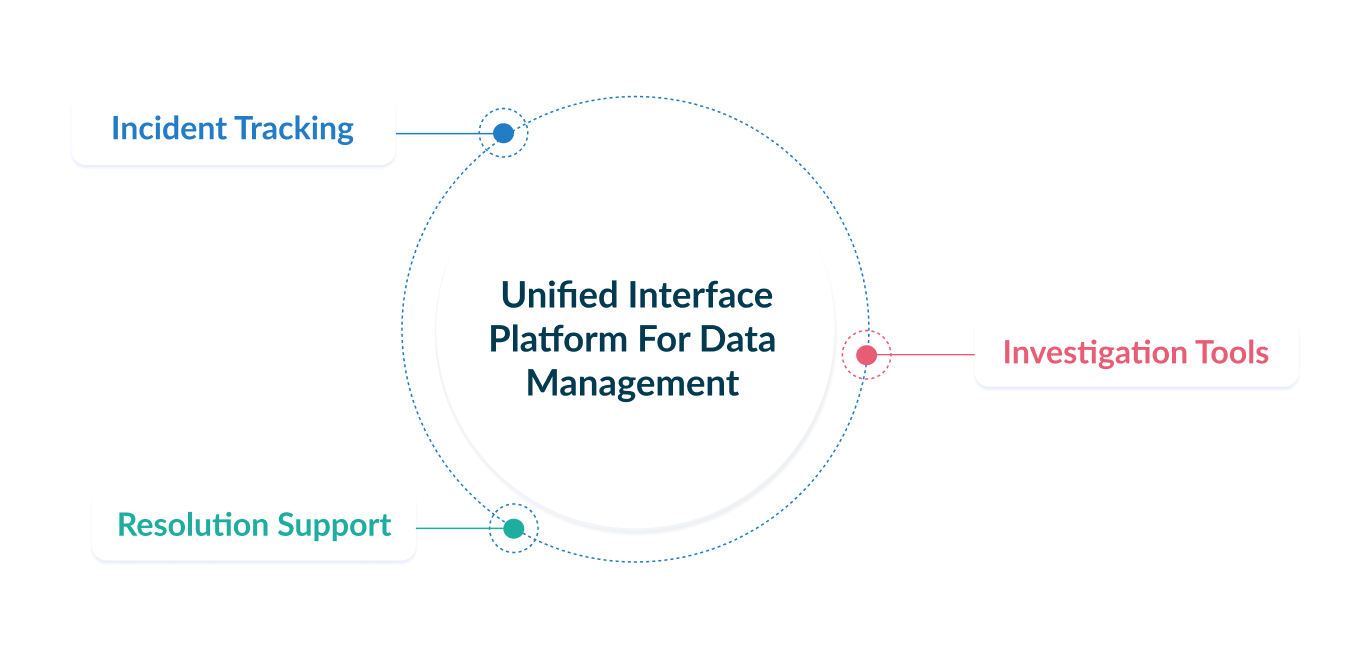How Databand Takes Observability Beyond Monitoring (And Improves Your Data Health)
6 min read
Summary
As organizations deal with increasingly larger volumes of data, there is a growing need for effective tools that can monitor, manage, and ensure the quality of this data. And that’s where IBM Databand comes into play. Unlike traditional data monitoring methods that might only alert system failures, Databand revolutionizes observability by monitoring, understanding, and improving the overall health of data. It represents a shift towards more sophisticated and capable tools in managing the complexities of modern data analytics systems and completely changes how organizations approach data quality and integrity. So, let’s learn more about this incredible system and how it can improve the quality of your company’s data.
Data Observability vs. Data Monitoring
Before we go deeper into how Databand can impact companies, it’s important to understand the concept of data observability and how it differs from data monitoring. Unlike traditional data monitoring, which tends to be reactive (primarily alerting teams when something has already gone wrong), data observability offers a much more expansive and proactive view.
Data observability focuses on the health and operational context of data within an organization. As a data observability platform, Databand can alert teams to issues and also give vital information about the problem, like:
What happened: It identifies the specific nature of the data incident or anomaly, from unexpected data loss and data quality discrepancies to sudden changes in data patterns.
Where it occurred: It pinpoints the exact location or source within the data architecture where the issue arose. This could be within a particular database, data pipeline, or data set.
Why it happened: it seeks to understand and convey the underlying causes of the data incident. These causes could involve interactions between different data sources, failures in data processing pipelines, or issues related to data ingestion processes.
Dependencies impacted: It maps out how the identified issue affects other elements within the data system. For example, it can understand which processes, reports, or applications rely on the affected data and how their functionality might be compromised.
Data observability is a significant step forward, but that doesn’t mean data monitoring is left out. It remains a vital building block of the information that data observability provides.
This new approach allows teams to detect and diagnose the issue quicker, which means they can take preventive action much faster and ensure the reliability and integrity of the data.

The Rise of Data Observability with Databand
Databand is another step in the evolution of proactive data management and observability. Aside from being a tool for ensuring data quality, it’s a solution designed to improve how data teams interact with their ecosystems. But let’s start from the beginning.
What is Databand?
Databand is a state-of-the-art data observability platform that provides a holistic view of the health and performance of an organization’s data infrastructure. As we mentioned before, it doesn’t just detect system failures. It also offers continuous, real-time observability across the entire data pipeline.
This includes data ingestion, processing, storage, and analysis stages. By relying on machine learning algorithms, Databand automatically identifies, diagnoses, and alerts teams to data anomalies, inconsistencies, and failures, as well as provides actionable insights to address these issues as quickly as possible.

Advantages of Databand
Databand completely changes the paradigm of an organization’s data management strategy. Let’s examine areas where Databand significantly improves operational efficiencies and data reliability.
1. Improving Data Quality
Databand is created with a relentless focus on improving data quality. This commitment is reflected in its advanced ML-powered anomaly detection capabilities. Unlike traditional systems that passively monitor data, Databand actively scans data both in transit (while it moves between systems) and at rest (when stored). With Databand in place, discrepancies, inconsistencies, or anomalies are detected within hours instead of days.
Along with immediate detection, Databand also alerts teams that the incident has happened, allowing them to prevent further propagation of errors through the data pipeline. This fast reaction is significant for organizations that rely on data accuracy for analytics, reporting, and decision-making. Without this, their decisions might be misguided, strategies misinformed, and their bottom line affected.
Another important aspect of Databand’s ML algorithms is its ability to learn, adapt, and improve its ability to detect anomalies over time. Simply put, the system becomes more efficient at detecting and alerting irregularities, reducing false positives, and ensuring that teams focus on genuine issues

2. Automated Root Cause Analysis
Traditionally, diagnosing data incidents has been a time-consuming process that relied on manual examination of logs and metrics to identify the source of the problem. Databand allows organizations to automate this process by utilizing advanced algorithms and machine learning to analyze data patterns and anomalies.
Once the anomaly is found, it quickly identifies the root cause of data incidents, whether they stem from errors in the data pipeline, unexpected changes in data sources, or system failures. This quick diagnosis allows teams to address issues directly with minimal downtime while still being able to maintain the continuous flow of accurate and reliable data.
The benefit here is twofold: it minimizes the manual labor involved in troubleshooting and significantly speeds up the resolution time. This allows businesses to maintain data-driven operations uninterrupted.
3. Guaranteed Data SLAs
For organizations that rely on timely, accurate data to inform their operations and strategic decisions, Data Service Level Agreements (SLAs) are of vital importance. Databand is the most advanced system for ensuring these agreements are always upheld.
Its ability to guarantee data SLAs stems from its comprehensive monitoring and anomaly detection system, which scans for and identifies issues in real-time, often before they impact the end users or breach SLA thresholds.
This preemptive approach ensures the delivery of high-quality data and builds trust among stakeholders by consistently meeting or exceeding the agreed-upon data standards.
By implementing Databand, organizations can avoid the reputational damage and potential financial losses associated with failing to meet data SLAs, making it an invaluable tool for maintaining high data quality and reliability standards.
The Importance of Unified Interface for Data Management
If not detected on time, incidents such as discrepancies, errors, or anomalies can disrupt operations and create bottlenecks that can easily turn into sinkholes of time and money. Traditionally, addressing these incidents meant navigating multiple tools and communication channels. The entire process was unnecessarily time-consuming and prone to errors.
Databand simplifies this process by offering a unified interface for monitoring, investigating, and resolving data issues. In simpler words, it streamlines the entire incident management lifecycle. Aside from greatly improving the visibility and control over data health, this consolidation also accelerates the response time to incidents and minimizes disruptions to data-driven operations.
The platform also makes incident management more efficient, and here’s how.
Incident tracking capabilities alert teams of issues in real time. At the same time, investigation tools quickly reveal the underlying causes, drastically cutting down diagnostic times. Next, resolution support, including suggested corrective actions and possible automation of fixes, helps restore data systems to their optimal state more swiftly.
Now, technical efficiencies aside, Databand’s unified interface opens up the room for more collaboration between teams. Through various communication channels (like Slack, PagerDuty, email, etc.), the system sends personalized notifications for incidents, including delayed data deliveries, unforeseen schema modifications, and irregularities in column-level metrics.
In the end, critical information is delivered to those who need it, when they need it, and allows them to respond to the incident on time.

How Databand Improves Efficiency and Saves Costs
All the advantages we have listed so far boil down to how it saves your organization’s costs and improves efficiency. Its ability to almost instantly pinpoint affected processes in the data pipeline allows teams to focus on mitigating issues, thereby minimizing downtime and maintaining continuous operational flow. This rapid identification and response capability is especially valuable for organizations that rely on real-time data for decision-making, as it allows the operation to remain uninterrupted and responsive to the latest data insights.
But it doesn’t end there. Databand enables prioritization of incident responses based on the severity of data corruption. By utilizing sophisticated analysis tools to assess the impact of data incidents, teams can distribute their resources more effectively and focus on the most critical issues first. This strategic approach not only improves the health of the data ecosystem but also optimizes resource use, as it reduces the operational costs associated with managing data incidents.
Lastly, Databand’s unified error logging streamlines the troubleshooting process by providing deep and instantaneous insights into errors across the data pipeline. This consolidated view allows efficient diagnosis and rectification of issues. It also eliminates the need for multiple diagnostics tools and reduces the resources required for data incident management.
By offering a holistic perspective on pipeline errors and facilitating a deeper analysis of root causes, Databand helps companies avoid costly errors and ensures decision-making is based on accurate and reliable data. Through these capabilities, Databand supports organizations by maintaining their competitive edge, enhancing efficiency, and reducing overall costs.
To estimate how much your company would save annually, click here to access the Databand ROI Calculator.
How To Use Databand For Organizational Success?
With Databand’s real-time monitoring and analysis, organizations can proactively identify, diagnose, and address data incidents before they escalate. Its capacity to provide a holistic view of the data ecosystem creates a more nuanced understanding of data flows and interactions within the organization.
Databand’s core features, such as ML-powered anomaly detection and automated root cause analysis, streamline the process of maintaining data quality and integrity. These features allow data teams to quickly pinpoint the source of data discrepancies and implement targeted solutions. With this, they significantly reduce downtime and mitigate the risk of inaccurate information that could result in loss of both time and money.
Furthermore, the platform’s commitment to upholding Data Service Level Agreements (SLAs) offers organizations the confidence that their data handling practices meet the highest standards of quality and reliability. By ensuring that data SLAs are consistently met, Databand keeps the organization’s reputation safe and instills trust among stakeholders.
Ultimately, Databand’s unified management interface drastically simplifies data incident management. By consolidating data alerts, diagnostics, and incident resolution processes into a single, user-friendly platform, Databand enhances operational efficiency and allows for greater collaboration between data teams. At the same time, this cohesive approach accelerates the response to data incidents and empowers organizations to leverage their data assets more effectively.
Companies that adopt Databand can overcome the challenges of today’s data-intensive world with agility and precision and unlock new opportunities for growth and innovation.

Conclusion
In summary, it is obvious how Databand improves how businesses handle their data by offering an advanced solution for maintaining data quality and integrity. With its revolutionary features like Automated Anomaly Detection and a Unified Management Interface, companies will improve their operational efficiency and, consequently, significantly reduce their overall costs.
Databand is a tool specifically designed for the modern data-driven world that helps organizations stay ahead in managing and utilizing their data effectively. And with our help, this platform can become an irreplaceable part of your company.
As a proud IBM Gold business partner, we are committed to providing top-tier, transformative solutions and ensuring customer satisfaction. Our expert team is ready to assist you with everything from system design to seamless implementation and do whatever it takes to make the transition to enhanced data observability smooth and straightforward.
If you want to know more about how Databand can elevate your data observability, contact Innoboost today!
We will assess your current setup and show you how to optimize your data management strategies for better efficiency and savings.
You may also like…
Unlocking the Power of Custom AI with InstructLab
5 min readSummary In the dynamic landscape of artificial intelligence, the ability to create models tailored to unique business needs is more than a competitive edge—it's a necessity. InstructLab, a collaborative initiative from IBM and Red Hat, is revolutionizing AI...
Strengthening Authentication in the Digital Age with IBM Verify
5 min readSummary In today’s interconnected world, the importance of robust authentication systems cannot be overstated. As digitalization accelerates, safeguarding sensitive data and critical systems has become a top priority for businesses. Effective access...
From Data Chaos to Data Confidence: Real-World Use Cases of IBM Data Product Hub
5 min readSummary In a world where data streams in from every direction—transactions, patient records, supply chain logs, and more—businesses often face “data chaos.” Instead of powering innovation, their data sits scattered in different formats and systems, making it...




